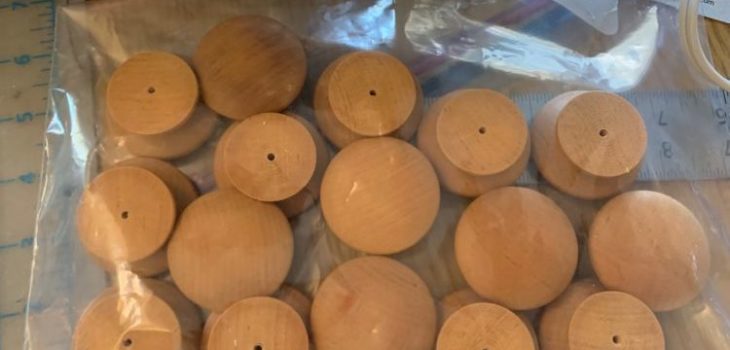
Look-alike snacks fool the eye — but not the…
Things aren’t always what they seem. Take things that look like snacks, but aren’t. Look-alike snacks, if you will.
My sister has a penchant for creating things. Most recently, she’s turned her talents to escape rooms. She crafted one, including a secret panel/hiding spot, in a spare bedroom for a friend’s birthday. (It’s really cool. You can read about it here.)
Look-alike snack: Nilla Wafers
Now, she wants to build a bigger, better one. She’s always on the lookout for things she can use. She has a closet full of cardboard, a garage with tools, scraps of wood and odds and ends, containers of paints, brushes and art supplies.
Recently, she scavenged the round wooden knobs off a bedroom set when the owner planned to replace the hardware with something more contemporary. She was thrilled. I bagged them up in a Ziploc freezer bag. When we got home, I tossed them on the kitchen counter.
For the next day, we both kept thinking it was a bag of Nilla Wafers. They are the right color and size. I wouldn’t eat a Nilla Wafer now, but still, it made me think of them each time I saw the bag of knobs.
And that made me think of puppy chow.
Look-alike snack: Puppy chow
You might remember the treat made with Chex-style cereal, chocolate and powdered sugar. I don’t know that I ever made it, but I liked eating it. It looked like dog food — whitish, brownish, clumpy pieces – hence the name: puppy chow. It did not look appealing, but it tasted good.
One day, many years ago, I came bounding up the stairs at our house. The dishwasher was right at the top of the stairs, by the kitchen door, and on top of it was a zippered bag of puppy chow. My mother-in-law lived next door at the time, and she often brought over goodies she got from school. She wasn’t a cook herself, but she knew how to score treats. Without hesitating, I opened the bag, dumped a handful into my hand, shoved it in my mouth and chewed.
It wasn’t puppy chow. I realized that as soon as my teeth and tongue connected with it.
It was sand. Chunks of clumpy, grainy, yucky sand.
Snack doesn’t fool tastebuds
My son had a dinosaur dig kit, which he received for his birthday or Christmas. It was a flat piece of sandstone-type material with little tools. He acted as archeologist and uncovered the plastic “dinosaur bones” hidden in the “stone.” My mother-in-law, with a geology minor, helped him do it. Instead of throwing out the used sand, she put it in a sandwich bag and left it on the dishwasher. I have no idea why. Truthfully, I don’t think she even knew why she kept it, but she laughed about it when I told her.
I spit out the sand and washed out my mouth. But that was the last time I ate puppy chow. Funny how I never had a taste for it again. I also was much more suspect of every “treat” that made its way into our house.
So those “Nilla Wafers” make me smile to myself, even though I have no desire to bite into a wooden disc.
Be a Better Writer Tip
If you use brand names in your copy, you should capitalize them. In this blog, I used Nilla Wafer, Ziploc and Chex, all brand names for products. Puppy chow is a generic term for a snack, so it’s not capitalized (except at the beginning of a sentence). It’s not necessary to use quote marks with brands. I used them in this story to indicate when the wooden discs resembled Nilla Wafers.
If you are unsure if something is a brand, look it up. A quick Google search will answer your question, if you don’t have an AP Stylebook. There is no need to use the registered trademark R in a circle or anything, either. Simply spell the product name properly and explain what it is, if it’s not a common term. In this case, the brands are common enough that readers should recognize them.



